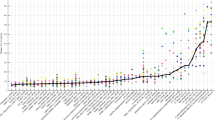Abstract
Literature regarding the heterogeneity of and preferences for radiology workstation design—and, in particular, the digital workspace of the radiology workstation—is scant. The purpose of this study was to determine the nature of the digital environments across the specialty and the degree of satisfaction users associated with the particular facets of those environments. A survey was sent to the membership of the Association of University Radiologists in February 2015. The survey comprised 10 questions establishing demographics, current typical workstation setup, perceived satisfaction with that setup, and preferences for potential altered setups. A total of 336 radiologists responded, with a cross-section similar to that described in the 2015 ACR annual workforce survey (1). Although there was a rough split in the number of radiologists using one or two non-diagnostic monitors (46 vs. 51%, respectively), the strong majority (75%) of radiologists use two diagnostic monitors. Users of two non-diagnostic monitors were more likely to keep open the case info (87 vs. 68%) and EMR (84 vs 68%). More senior radiologists tended to find the current setup easy more frequent than younger radiologists, and the latter group was more likely to believe additional monitors would be helpful. Although many radiologists are comfortable with their computing workflows, a significant number indicate dissatisfaction and may be interested in being able to specify the amount of monitor space with which they can work. Additional monitors may promote improved quality in addition to any potential productivity gains.




Similar content being viewed by others
References
Hoffmann JC, et al: Combating the health risks of sedentary behavior in the contemporary radiology reading room. AJR Am J Roentgenol 8:W1-W6, 2016
Pollard BJ, et al: The effects of ambient lighting in chest radiology reading rooms. J Digit Imaging 25(4):520-526, 2012
Zwemer J, et al: Effect of ambient sound masking on the accuracy of computerized speech recognition. Radiology 252(3):691-695, 2009
Van Ooijen PM, Koesoema AP, Oudkerk M: User questionnaire to evaluate the radiological workspace. J Digit Imaging 19 Suppl 1:52-59, 2006
Bennett WF, et al: PACS monitors: an evolution of radiologist's viewing techniques. J Digit Imaging 15 Suppl 1:171-174, 2002
Anderson J, Colvin J, Tobler N: Productivity and multi-screen displays. Print, 2007
The 30-inch Apple Cinema HD display productivity benchmark. Pfeiffer Consulting. Print. Pfeiffer Report, 2005
Microsoft Research: Two screens are better than one. Print, 2003
Richtel M: In Data deluge, multitaskers go to multiscreens. The New York Times. A1. Print, 2012
Manjoo F: Discovering two screens aren’t better than one. The New York Times. Print, 2014
Beale R, Edmondson W: Multiple carets, multiple screens and multi-tasking: new behaviours with multiple computers, Proceedings of the 21st British HCI Group Annual Conference on People and Computers: HCI...but not as we know it, September 03-07, 2007, University of Lancaster, United Kingdom
Ball R, et al: Evaluating the benefits of tiled displays for navigating maps. Human-Comput Interact, 2005.
Sabri A, Ball R, Bhatia S, Fabian A, North C: High-resolution gaming: interfaces, notifications, and the user experience. Interact Comput J 19(2): 151–166, 2007
Bergen L, Grimes T, Potter D: How attention partitions itself during simultaneous message presentations. Hum Commun Res 31:311 (2005)
Greenfield PM: Technology and informal education: what is taught, what is learned. Science 323(5910):69-71, 2009
Foerde K, Knowlton BJ, Poldrack RA: Modulation of competing memory systems by distraction. Proc Natl Acad Sci U S A 103:11778, 2006
Hembrooke H, Gay G, J. Comput. The laptop and the lecture: the effects of multitasking in learning environments. High Educ 15:46, 2003
Balint BJ, et al: Do telephone call interruptions have an impact on radiology resident diagnostic accuracy? Acad Radiol 21(12):1623-1628,2014
McEnery KW: Radiology information systems and electronic medical records. Reston, American College of Radiology, 2013. Print. IT Reference Guide for The Practicing Radiologist
Bluth EI, et al: The 2015 ACR Commission on Human Resources Workforce Survey. J Am Coll Radiol 12(11):1137-1141,2015
Author information
Authors and Affiliations
Corresponding author
Ethics declarations
Sources of Support
None.
Conflict of Interest
The authors declare that they have no conflict of interest.
Appendix
Appendix



Rights and permissions
About this article
Cite this article
Sharma, A., Wang, K. & Siegel, E. Radiologist Digital Workspace Use and Preference: a Survey-Based Study. J Digit Imaging 30, 687–694 (2017). https://doi.org/10.1007/s10278-017-9971-8
Published:
Issue Date:
DOI: https://doi.org/10.1007/s10278-017-9971-8




